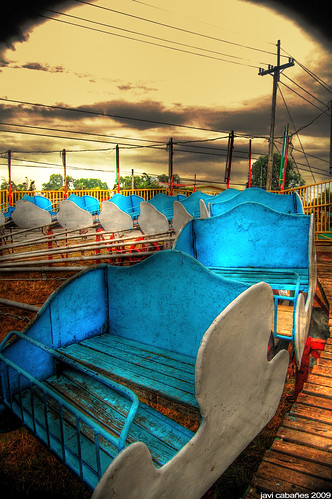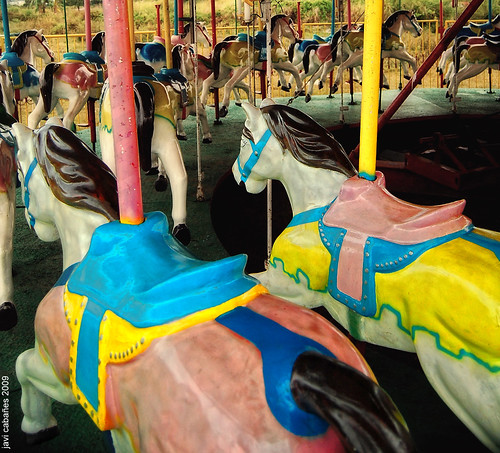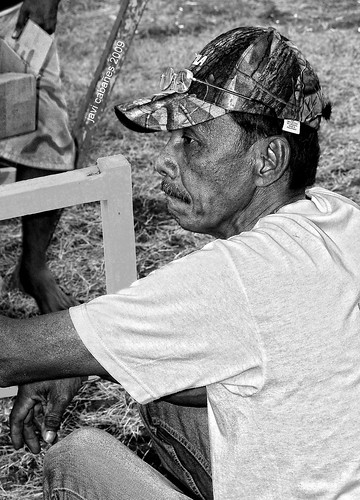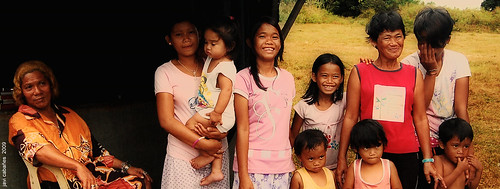It caught the left side of my peripheral vision. A ferris wheel towering over an empty field where cows grazed every morning about 5 kilometers away from work. The road curves to the right when the field comes into full view and there I began to see it one by one as if it were slowly peeking out of the shadows. The ferris wheel joined by others of its kind. An octopus. A small roller coaster. And a carousel. Immediately I was enchanted. An empty carnival standing on its own on a vacant piece of land by the roadside called Paliparan, Cavite. There were no walls that barred anyone from entering. There were no gates that called for an entrance fee or some other kind of social introduction.

There was something about the overcast sky that was beckoning. It felt like one of those empty castles that waited exploration or a city of ruins that waited discovery. For me to catch a glimpse of this on my way to work was a keepsake and recurring thought that begged to be woven in a story. I’ve been thinking about a Saturday that will allow me to finally pay a visit.
That Saturday was February 7. 1:00pm in the afternoon. I parked the car by the side of a dirt road and together with my friend we walked across the carnival grounds. It was somehow eerie and I couldn’t help but feel that I was trespassing even if there were no signs that told me I was. When I laid my feet on the damp grass, I felt the soft earth. The soil wasn’t tilled and it told me that this land wasn’t really paved to have a carnival sitting on it. I looked around and saw little box shacks situated on the north, east and west side of the entire carnival perimeter. As if on unison, heads started to peek out from curtained doors and some children came out from hiding.

We were clearly strangers. So I initiated by calling out “Magandang umaga po!” and introduced myself as an advocate writer for the Outlooke Pointe Foundation. I asked if we can take pictures and told them we want to be able to capture the story that lies behind their different and fascinating livelihood.
A tall man stepped out of the north end. He was thin and dark and sported a mustache. His nose was pointed and his skin looked like it was sun burnt. I approached him and smiled to show ease and introduced myself again. He said his name was Bob Mariano. When I explained what we wanted to do he nodded and simply gave us an okay.
It has been a long time since I saw vintage carnival rides sitting on raw untilled soil. The last time I remember seeing these rides was when I attended school fairs in the 1990s. These days we’d see all sorts of rides merrily grazing over colored theme parks like Enchanted Kingdom in Sta. Rosa Laguna or the newly opened Disneyland in Hongkong. But the stories behind the commercialization of theme parks now did not draw me in unlike this one.

A rusty roller coasting and a faded carousel smelled like rain. Damp wooden floor boards for steps elevated them from the ground. I walked around some more and saw more people coming out with tools and wood. They started hammering them together to form a booth at the center.
Manong Bob was looking over the men that were building and sat a while a few feet away from us. I sensed him relax when he saw that we didn’t mean to do anything else. So I went up to him and talked to him again. I found out that they have been on that land for about a month. He said that they came from Binan Laguna. He travels with other families who own a carnival ride and agree to visit town after town from Cavite to Laguna talking to town officials and landowners so they can set up tent on their vacant property to put up carnival rides for townsfolk to enjoy.

Manong Bob has been doing this for 41 years. On 1968 he has inherited the livelihood from his parents and continued the business ever since. He enjoys it and finds that he has gotten used to the lifestyle of moving place to place. I asked him if he ever rode the rides he owned and he said yes. He said he’s never been afraid of riding them because he grew up with them.
There was a slight glint in his eye when he said this. Like some sort of pride shone through at remembering the memory. He didn’t want to have his picture taken for some reason and we didn’t insist. We walked over to his shack and met his family. He has a young wife and a young beautiful daughter who looked straight into the camera when we took her photo.
We met a guy named Alex. He was an interesting looking fellow who wore a lot of rings and bracelets that I became fascinated with. I asked him where he bought them and he said there were a lot of silver made jewelry in Binan Laguna being sold for only 200 pesos. My jaw dropped as I looked at my own silver ring that cost me 800 pesos from a mall. We took their pictures and there were a lot of smiles when we showed them how they looked from the LCD.

That day I experienced what it was like to have fun in a small town way. Where close knit circles huddled to excitedly hear a new story or entertain a visitor. Where the smiles became a genuine expression of ease and comfort. For 2 hours I was immersed with their stories of nomadic living and realized that I was talking to real life Filipino gypsies. Whose lifestyle has always captivated me because of such mystery and freedom.
That day I realized that there were many in our country who uphold the tradition of continuing what has been passed down through generations because it was an honor and a duty to do so. It did not only happen in upper class society but those of whom found home in the outskirts of posh cities in the Metro. It did not happen only with big family corporations or small entrepreneurial businesses but also in the likes of these groups who travel like nomads living month after month on giving a town a space to experience and enjoy the freedom that they’ve found when their own journey becomes their home.

I salute and honor their livelihood because I realized that in their own way and in their own scale, I knew that if they carried the business this long, they have somehow made a difference if not on one small town but maybe perhaps one child who felt the wind on her face and the rain frolic on her cheeks giving her a reason to smile that day from high up the ferris wheel’s peak.
_______________
credits:
pictures by Javi Cabanes





4 comments:
Interesting coverage... awesome pictures...
nothing short of enchanting.
any other passerby would have dismissed the metal and wood ensemble as inconsequential, obsolete matter in the middle of a field that would be gone in a month or so. but you ventured and captured the life hidden in all of that.
i love how the children peeked out at you as you got closer, just like in films and books of fairy worlds hidden behind flower petals and blades of grass, or even of the toys in Sid's room in Toy Story.
i never knew that carnivals like this could be family legacies, and how lovely it is to have discovered that! i wish i were with you there. for some reason, everything you have described in this entry reminds me of that underground tunnel place in the film Hunchback of Notre Dame, the tunnel place where Esmeralda lives with her big colorful troupe. in a way this nomad life is inviting: how it has a home, but no boundaries. it's like art manifested into a lifestyle.
Hey Adi,
I love how you are able to perceive what I am trying to capture in words and pictures. :) You got everything right adi and it's lovely how you are still able to resonate with me like this though miles apart. I really wish you were with us.
Thanks Sidney!
Post a Comment